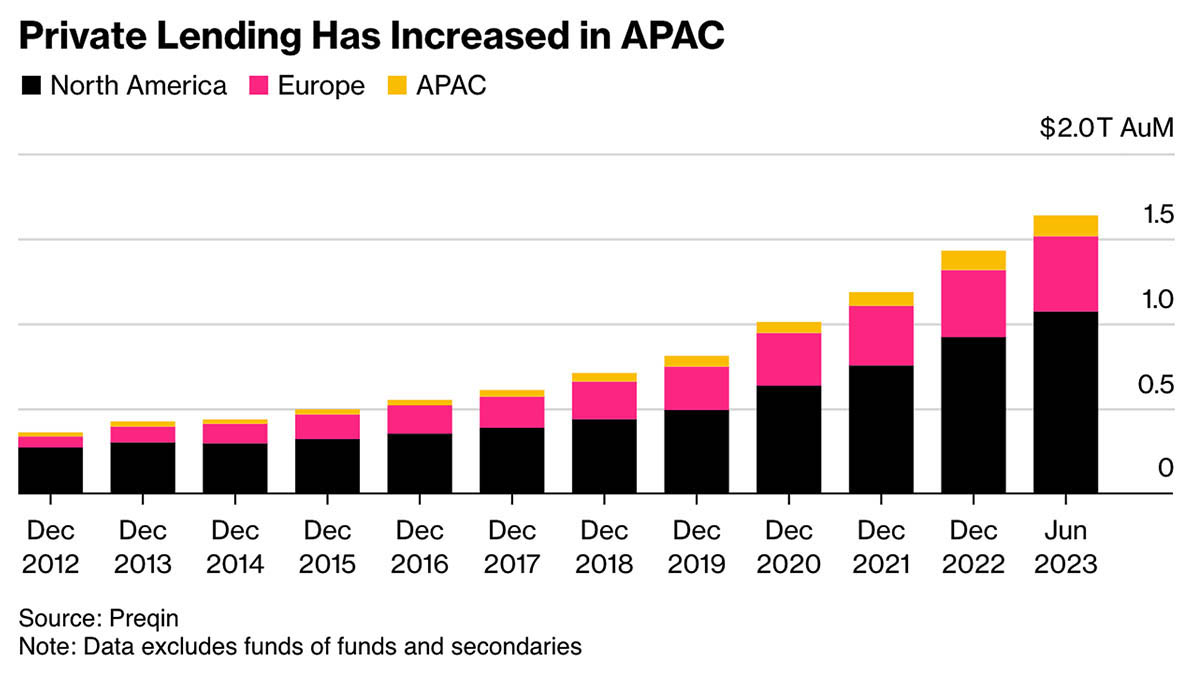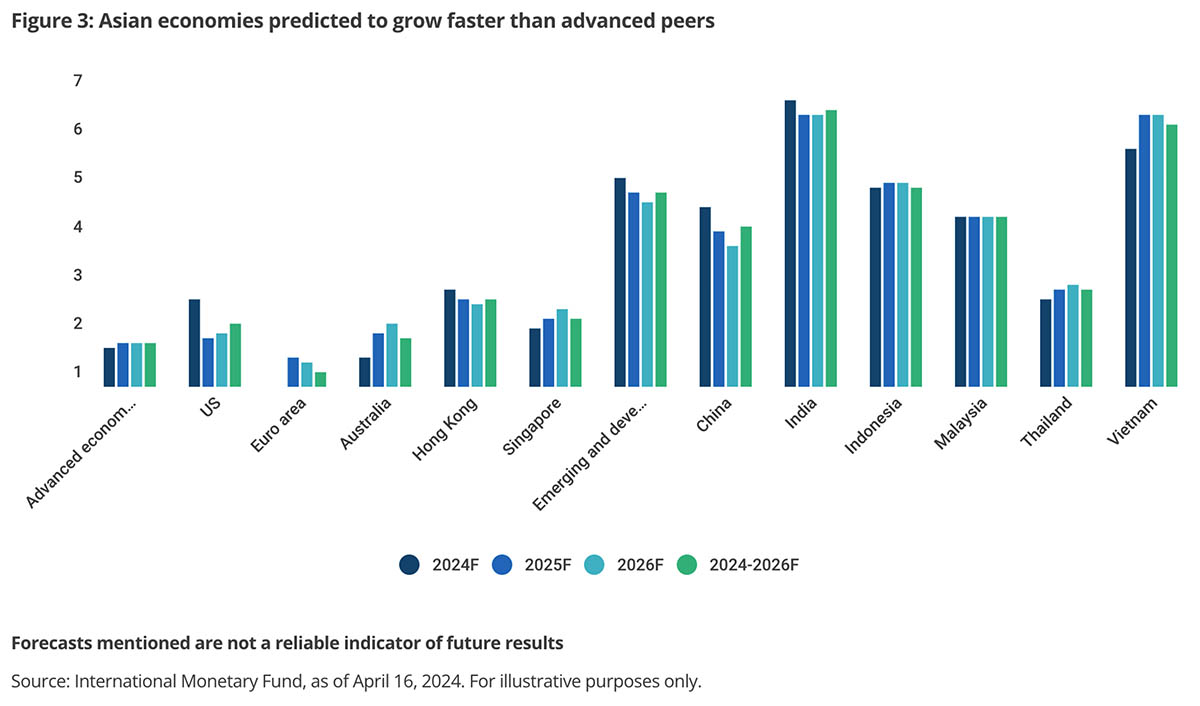Private credit in Asia isn’t just getting bigger, it’s becoming more diverse
Private credit in Asia is small in proportion to regional economies and has significant scope to grow. It will also become more diverse, with specialty financing providers meeting specific needs alongside funds with more established strategies.
Private credit assets under management in the Asia Pacific region have quadrupled over the past decade, reaching US$124 billion as of September 2023, according to alternative assets data provider Preqin.[1] But that makes up only about 6% of the global private credit market.[2] Considering APAC now accounts for more than two-fifths of global GDP[3] and is expected to drive over 60% of global growth,[4] there is clearly much further room for its private credit market to expand.
Figure 1: Private Credit is Making Inroads in APAC

Image source: https://www.bloomberg.com/news/articles/2024-05-20/deutsche-bank-s-private-credit-business-beefs-up-team-in-asia
Indeed, with tighter bank lending policies around the world and a dramatic contraction in high-yield bond issuance in Asia Pacific,[5] private credit will become increasingly crucial to sustaining the region’s growth. Crucially, it will also help bridge the estimated $2.4 trillion annual financing gap for small and medium-sized enterprises across the region’s developing economies.[6]
For now, banks remain by far the dominant providers of credit across Asia Pacific, accounting for a 79% share, compared with 54% in Europe and just 33% in the US, according to KKR.[7] Within the region, the share ranges from 85% in mainland China to 59% in India (see Figure 2). If the US and Europe are any guide, banks’ share of credit in the region could decline over time – even if their balance sheets do not – as economies grow and private credit providers increase their capital commitments to Asia Pacific.
Figure 2: Banks’ share of credit across APAC

Image source: https://www.pwchk.com/en/asset-management/navigating-the-region-apr2024.pdf
Private credit in the region is also small compared with private equity: the ratio of private equity to private credit assets is 30.8 in Asia Pacific, compared to 5.2 in the US and 3.5 in Europe.[8]
Filling the gap
According to lenders and borrowers, private credit’s growth in Asia Pacific is being driven largely by its ability to meet financing needs that banks often cannot.[9] Their different capital models and regulatory frameworks mean that private credit providers can typically finance a broader range of assets, credit profiles and corporate situations than banks.
So-called direct lending strategies – where investors provide financing directly to typically mid-market companies – are considered to have particular potential in Asia Pacific as they direct credit to under-banked borrowers. This means that private credit can complement bank financing in Asia Pacific and contrasts with the US and Europe, where private credit and bank lenders are more often in competition.[10]
According to a recent Bloomberg survey of private credit providers active in Asia Pacific, the education, healthcare and consumer-facing sectors are the most promising for deals. Strong demand for capital will be driven by the region’s prevailing demographic shifts, including fast-growing mass affluence in India and Southeast Asia, as well as rapidly aging populations in China and the region’s developed economies.[11]
Private credit is also well-positioned to fill the funding gap for the energy transition, which is estimated at $4 trillion globally each year.[12] Institutional investors are already a major source of funding for transition-related assets in Europe, the US and Australasia – and that that trend is likely to be extended across Asia Pacific.[13]
Growing in diversity
Private credit isn’t just getting bigger in Asia Pacific, though, it is set to become more diverse. Global asset managers will likely deploy increasing amounts of capital in funds dedicated to established strategies, such as leveraged finance, special situations and direct lending.
But these do not include more specialized forms of lending against assets and cashflows that many banks also find hard to finance. We expect a more complex financial ecosystem to evolve with a broader range of financiers meeting different needs.
This dynamic is already gaining momentum in the US, where ‘specialty finance’ is attracting growing interest as a new area of opportunity in private credit. Oliver Wyman estimates that specialty finance – including lending related equipment leases, trade receivables and royalty agreements – could be a $5.5 trillion market in the US alone.[14]
There are many ways that specialised lending could grow in Asia Pacific, too. In a region that has surpassed the US in financial wealth since 2008, it would be natural for lending against financial assets such as equity holdings to be one of them. And given projections for continued wealth creation in Asia Pacific – HSBC forecasts that wealth in Asia excluding Japan will soon overtake that of the US – securities-backed financing clearly has the potential for rapid growth as well.[15]
Figure 3: Asia Pacific is set to dominate global GDP growth

There is an alternative
In several of Asia Pacific’s most dynamic economies, bank lending to non-financial private companies as a percentage of GDP has declined over the past three years, according to data from the Bank for International Settlements. In other words, in countries such as Indonesia,[16] Thailand[17] and Malaysia,[18] which have recovered strongly from the pandemic, businesses looking to capitalize on that momentum and expand are faced with diminished access to funding from banks.
We therefore see scope for private credit to perform an increasingly vital function in channelling capital towards the region’s continued growth and development.
Large fund platforms will continue to dominate the biggest private credit categories, but demand for specialized financing secured by a wide range of assets will create more funding options for entrepreneurs and companies in the region.
Unlocking liquidity from equity holdings has considerable potential in Asia Pacific. Family-owned businesses dominate regional capital markets, accounting for over 60% of listed companies in Southeast Asia, for example.[19] The region’s wealthiest families are also significant investors in global equities: a UBS survey of global family offices with collective wealth of over $600 billion indicated that respondents from the region allocated 26% of their assets[20] All of this implies a significant pool of assets that can be used to access liquidity, and financing from EquitiesFirst makes this possible. We enable professional, accredited and sophisticated investors to raise finance against their equity holdings, even in mid- or small-cap stocks. This provides flexible capital for a wide variety of purposes, commonly including investment, on-lending to family-owned companies debt repayment and portfolio diversification.
Strong economic fundamentals and a large universe of unutilised collateral in Asia Pacific suggest that specialty financing against equity holdings will become an increasingly important part of the region’s growing credit market. For major shareholders in listed companies, there is a real alternative to bank lending.
[1] https://www.scmp.com/business/banking-finance/article/3261676/private-credit-market-big-story-asia-though-institutional-investors-have-become-selective-say
[2] https://asia.nikkei.com/Opinion/Private-credit-can-help-fill-Asia-s-growing-financing-gap
[3] https://www.mckinsey.com/mgi/our-research/asia-on-the-cusp-of-a-new-era
[4] https://asia.nikkei.com/Economy/Asia-to-drive-60-of-global-GDP-growth-in-2024-led-by-India-IMF
[5] https://debtexplorer.whitecase.com/leveraged-finance-commentary/high-yield-issuance-rallies-in-western-markets
[6] https://www.scmp.com/business/banking-finance/article/3251942/asian-private-credit-players-rush-bridge-funding-gap-smes-and-sectors-education-technology
[7] https://www.kkr.com/content/dam/kkr/insights/pdf/private-credit-in-asia-pacific.pdf
[8] https://www.bloomberg.com/news/articles/2023-11-27/kkr-sees-private-credit-returns-in-asia-beating-us-and-europe
[9] https://www.privatedebtinvestor.com/the-gaps-opening-in-asia-pacific-private-debt/
[10] https://www.privatedebtinvestor.com/the-gaps-opening-in-asia-pacific-private-debt/
[11] https://www.bloomberg.com/news/articles/2024-02-27/private-credit-sees-more-growth-in-asia-as-banks-pull-back
[12] https://www.scmp.com/business/banking-finance/article/3255455/transition-finance-seen-crucial-tool-fight-against-climate-change-asia
[13] https://www.infrastructureinvestor.com/the-role-of-private-credit-in-driving-the-net-zero-transition/
[14] https://www.oliverwyman.com/our-expertise/insights/2024/apr/private-credit-next-act-bank-resurgence.html
[15] https://www.research.hsbc.com/C/1/1/320/svKzVQm
[16] https://data.bis.org/topics/TOTAL_CREDIT/BIS,WS_TC,2.0/Q.ID.P.B.M.770.A
[17] https://data.bis.org/topics/TOTAL_CREDIT/BIS,WS_TC,2.0/Q.TH.P.B.M.770.A
[18] https://data.bis.org/topics/TOTAL_CREDIT/BIS,WS_TC,2.0/Q.MY.P.B.M.770.A
[19] https://www.businesstimes.com.sg/opinion-features/embracing-change-future-proofing-family-businesses-s-e-asia
[20] https://www.ubs.com/global/en/family-office-uhnw/reports/global-family-office-report-2024.html
Disclaimer
Past performance does not guarantee future returns, and individual returns are not guaranteed or warranted.
This Document is intended solely for accredited investors, sophisticated investors, professional investors, or otherwise qualified investors, as may be required by law or otherwise, and it is not intended for, and should not be used by, persons who do not meet the relevant requirements. The content provided herein is for informational purposes only and is general in nature and not targeted to any specific objective or financial need. The views and opinions expressed in this Document have been prepared by third parties and do not necessarily reflect the views and opinions of EquitiesFirst. EquitiesFirst has not independently examined or verified the information provided herein, and no representation is made that it is accurate or complete. Opinions and information herein are subject to change without notice. The content provided does not constitute an offer to sell (or solicitation of an offer to purchase) any securities, investments, or any financial products (“Offer”). Any such Offer shall only be made through a relevant offering or other documentation which sets forth its material terms and conditions. Nothing contained in this Document shall constitute a recommendation, solicitation, invitation, inducement, promotion, or offer for the purchase or sale of any investment product by Equities First Holdings, LLC or its subsidiaries (collectively, “EquitiesFirst”), nor shall this Document be construed in any way as investment, legal, or tax advice, or as a recommendation, reference, or endorsement by EquitiesFirst. You should seek independent financial advice prior to making an investment decision about a financial product.
This Document contains the intellectual property of EquitiesFirst in the United States and other countries, including, without limitation, their respective logos and other registered and unregistered trademarks and service marks. EquitiesFirst reserves all rights in and to their intellectual property contained in this Document. The Document should not be distributed, published, reproduced or otherwise made available in whole or in part by recipients to any other person and, in particular, should not be distributed to persons in any country where such distribution may lead to a breach of any legal or regulatory requirement.
EquitiesFirst make no representation or warranty with respect to this Document and expressly disclaim any implied warranty under law. You acknowledge that EquitiesFirst is not liable under any circumstances for any direct, indirect, special, consequential, incidental, or punitive damages whatsoever, including, without limitation, any lost profits or lost opportunity, even if EquitiesFirst has been advised of the possibility of such damages.
EquitiesFirst makes the following further statements that may be applicable in the stated jurisdiction:
Australia: Equities First Holdings (Australia) Pty Ltd (ACN: 142 644 399) holds an Australian Financial Services Licence (AFSL Number: 387079). All rights reserved.
The information contained on this Document is intended for persons located in Australia only and classified as a Wholesale Client only as defined in Section 761G of the Corporations Act 2001. The distribution of information to persons outside this criteria may be restricted by law and persons who come into possession of it should seek advice and observe any such restriction.
The material contained in this Document is for information purposes only and should not be construed as an offer or solicitation or recommendation to buy or sell financial products.
The information contained in this Document is intended to be general in nature and is not personal financial product advice. Any advice contained in the Document is general advice only and has been prepared without considering your objectives, financial situation or needs. Before acting on any information, you should consider the appropriateness of the information provided and the nature of the relevant financial product having regard to your objectives, financial situation and needs. You should seek independent financial advice and read the relevant disclosure statements or other offer documents prior to making an investment decision about a financial product.
Forecasts are not guaranteed, and undue reliance should not be placed on them. This information is based on views held by Equities First Holdings (Australia) Pty Ltd as at the publishing date of this material.
Dubai: Equities First Holdings Hong Kong Ltd (DIFC Representative Office) at Gate Precinct Building 4, 6th Floor, Office 7, Dubai International Financial Centre (commercial license number CL7354) is regulated by the Dubai Financial Services Authority (“DFSA”) as a Representative Office (DFSA Firm Reference No.: F008752). All rights reserved.
The information contained in this document is intended to be general in nature, and, to the extent that it is perceived as advice, any advice contained in this document is general advice only and has been prepared without considering your objectives, financial situation, suitability of the financial products or your needs.
The material contained in this document is for information purposes only and should not be construed as financial advice, including an offer or solicitation or recommendation to buy or sell financial products. The information contained in this document is intended to be general in nature and any advice contained in this document is general advice only and has been prepared without considering your objectives, financial situation, suitability of the financial products or your needs. Before acting on any information, you should consider the appropriateness of the information provided and the nature of the relevant financial product having regard to your objectives, financial situation and needs. If you do not understand the contents of this document, you should consult an authorised financial adviser.
This document relates to a financial product which is not subject to any form of regulation or approval by the DFSA. The DFSA has no responsibility for reviewing or verifying any documents in connection with this financial product. Accordingly, the DFSA has not approved this document or any other associated documents nor taken any steps to verify the information set out in this document, and has no responsibility for it.
Hong Kong: Equities First Holdings Hong Kong Limited is licensed under the Money Lenders Ordinance (Money Lender’s Licence No. 1659/2024) and to carry on the business of dealing in securities (Type 1 licence) under the Securities and Futures Ordinance (“SFO”) (CE No. BFJ407). This Document has not been reviewed by the Hong Kong Securities and Futures Commission. It is not intended as an offer to sell securities or a solicitation to buy any product managed or provided by Equities First Holdings Hong Kong Limited and is only intended for persons who qualify as Professional Investors under the SFO. This document is not directed to individuals or organizations for whom such offers or invitations would be unlawful or prohibited.
Korea: The foregoing is intended solely for sophisticated investors, professional investors or otherwise qualified investors who have sufficient knowledge and experience in entering into securities financing transactions. It is not intended for, and should not be used by, persons who do not meet those criteria.
United Kingdom: Equities First (London) Limited is authorised and regulated in the UK by the Financial Conduct Authority (“FCA”). In the UK, this Document is only being distributed and made available to persons of the kind described in Article 19(5) (investment professionals) and Article 49(2) (high net worth companies, unincorporated associations etc.) of Part IV of the Financial Services and Markets Act 2000 (Financial Promotion) Order 2005 (‘’FPO’’) and any investment activity to which this presentation relates is only available to, and will only be engaged in with, such persons. Persons who do not have professional experience in matters relating to investment or who are not persons to whom Article 49 of the FPO applies should not rely on this document. This Document is only prepared for and available to persons who qualify as Professional Investors under the Markets in Financial Instruments Directive.
